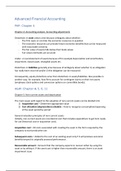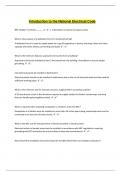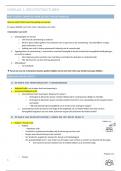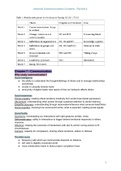Summary papers Business-level strategy
Boyd, J. L. and Bresser, R. K. 2008. Performance implications of delayed competitive responses: evidence
from the U.S. retail industry. Strategic Management Journal, 29: 1077-1096 2
Nadkarni, S., Chen, T. and Chen, J. 2016. The clock is ticking! Executive temporal depth, industry velocity, and
competitive aggressiveness. Strategic Management Journal, 37(6): 1132-1153 5
Sirmon, D.G., Hitt, M.A., Arregle, J.L. and Campbell, J.T., 2010. The dynamic interplay of capability strengths
and weaknesses: investigating the bases of temporary competitive advantage. Strategic Management
Journal, 31(13), pp.1386-1409. 7
Schilke, 2014. On the contingent value of dynamic capabilities for competitive advantage: The nonlinear
moderating effect of environmental dynamism, Strategic Management Journal 35(2), 179-203 10
Flammer C. 2013. Corporate Social Responsibility and Shareholder Reaction: The Environmental Awareness
of Investors, Academy of Management Journal, 56(3): 758-781 13
Hawn, O. and Ioannou, I. 2016. Mind the gap: The interplay between external and internal actions in the case
of corporate social responsibility. Strategic Management Journal, 37: 2569-2588. 15
Hatch, N.W. and Dyer, J.H. (2004), Human capital and learning as a source of sustainable competitive
advantage. Strategic Management Journal, 25: 1155-1178 18
Riley, S. M., Michael, S. C. and Mahoney, J. T. 2017. Human capital matters: Market valuation of firm
investments in training and the role of complementary assets. Strategic Management Journal, 38: 1895-191
21
Cassiman and Veugelers 2006. In Search of Complementarity in Innovation Strategy: Internal R&D and
External Knowledge Acquisition. Management Science, 52 (1) 23
Klingebiel, R. and Joseph, J. (2016), Entry timing and innovation strategy in feature phones. Strategic
Management Journal, 37: 1002-1020. 25
Overview all papers: 28
1
, Boyd, J. L. and Bresser, R. K. 2008. Performance implications of delayed competitive responses:
evidence from the U.S. retail industry. Strategic Management Journal, 29: 1077-1096
3 characteristics of first mover performance
1. Superior market insight
2. Entrepreneurial prowess
3. Competitive creativity
- Do first mover advantages lead to better performance? → Can they be sustained?
This paper:
- Develop theory on first mover and follower advantages by revisiting the issue of response timing
- Look at consequences fast vs delayed competitive responses
Past literature:
- Overlooks risks responding too fast
- Responding too fast can lead to performance disadvantages (making too hasty commitments)
Research question: What is the nature of the response timing-performance relationship?
- Prior research: the relationships of responder and first mover on performance are both linear
- This paper: considering other perspectives, conscious choices and competitive blind spots → only effect
of first mover on performance is linear
→ effect of responder on performance is curvilinear
Theory:
- Economics, marketing and management theory say: we need quick responses to competitive challenges
→ to limit the first mover in getting a competitive advantage
- Economics theory:
- Profit advantage of imitation (fast second > first mover)
- Cost advantage from learning from mistakes first mover
- Marketing theory:
- Response aggressiveness: fast marketing mix reactions to entry
- Management theory:
- Aggressiveness and fast responses
- Porter (1985):
- Quick response → first mover can't build barrier
- Quick response → signal incumbent commitment to defend market positions
- Quick retaliation is necessary to limit an attack
- Prior literature: mixed results → both fast and delayed responses have advantages
- This paper proposes a curvilinear relationship → intermediate response delays are best
- Focus of this paper on dynamic, competitive environments (in these environments, firms are
motivated to compete aggressively and firms are likely to make errors)
- The response-timing decision is a balancing act
- When firms respond too quickly there are too many uncertainties, when firms respond too
slowly this is not good for performance
2
, - Firms respond too quickly or too slowly because of (see Table 1):
- Bad luck: incorrect assumptions after analysis
- Conscious choice: deviate from appropriate timing scenario after analysis
- Blind spots: incomplete / incorrect analysis → leads to cognitive biases:
1. Limited perspective to frame problems
2. Escalation of commitment (nonrational)
3. Overconfidence in judgement
- First movers need time to absorb first mover benefits → a fast response by competitors means
the time of first movers is cut short
- Too late responses don’t harm first mover → more time to claim benefits (like greater
market share & profits)
- Too fast responses do harm first mover (even if the response is inferior) → first mover
can’t expand as planned
Hypotheses
- H1: Responder performance and response delay are related in an inverted U-shaped manner: Lower
performance will result for fast and late responders, and higher performance for firms with intermediate
response delays
- H2: First mover performance and response delay are related in a linear manner: As response delays are
longer (shorter), performance decreases are smaller (greater)
3
, Sample
- US retail industry → has intense rivalry
- 1994-2000
- 17 largest US department stores, 119 company years
Method
- Quantitative study
- Structured content analysis of press articles (competitive dynamics research)
- Nine move types: e.g. pricing moves, marketing moves, m&a moves, legal moves
- Explicit reference to an earlier action
- Competitive moves that are similar to earlier actions
- 12 months time frame response
- Event study methodology
- Stock effects → two-day event window
- Dependent variable: stock effects of responses (responder & original actor)
- Independent variable: response delay (difference date of the action and date of the response)
Results
- Response delays have dissimilar first mover and responder performance effects in a competitive industry
environment
- Hypotheses supported?
- H1 supported
- H2 supported
- The study uses multiple conceptual lenses
- Contribution: there is a direct link between response timing and stock market performance
- Limitations: small sample size, just one industry
4
Boyd, J. L. and Bresser, R. K. 2008. Performance implications of delayed competitive responses: evidence
from the U.S. retail industry. Strategic Management Journal, 29: 1077-1096 2
Nadkarni, S., Chen, T. and Chen, J. 2016. The clock is ticking! Executive temporal depth, industry velocity, and
competitive aggressiveness. Strategic Management Journal, 37(6): 1132-1153 5
Sirmon, D.G., Hitt, M.A., Arregle, J.L. and Campbell, J.T., 2010. The dynamic interplay of capability strengths
and weaknesses: investigating the bases of temporary competitive advantage. Strategic Management
Journal, 31(13), pp.1386-1409. 7
Schilke, 2014. On the contingent value of dynamic capabilities for competitive advantage: The nonlinear
moderating effect of environmental dynamism, Strategic Management Journal 35(2), 179-203 10
Flammer C. 2013. Corporate Social Responsibility and Shareholder Reaction: The Environmental Awareness
of Investors, Academy of Management Journal, 56(3): 758-781 13
Hawn, O. and Ioannou, I. 2016. Mind the gap: The interplay between external and internal actions in the case
of corporate social responsibility. Strategic Management Journal, 37: 2569-2588. 15
Hatch, N.W. and Dyer, J.H. (2004), Human capital and learning as a source of sustainable competitive
advantage. Strategic Management Journal, 25: 1155-1178 18
Riley, S. M., Michael, S. C. and Mahoney, J. T. 2017. Human capital matters: Market valuation of firm
investments in training and the role of complementary assets. Strategic Management Journal, 38: 1895-191
21
Cassiman and Veugelers 2006. In Search of Complementarity in Innovation Strategy: Internal R&D and
External Knowledge Acquisition. Management Science, 52 (1) 23
Klingebiel, R. and Joseph, J. (2016), Entry timing and innovation strategy in feature phones. Strategic
Management Journal, 37: 1002-1020. 25
Overview all papers: 28
1
, Boyd, J. L. and Bresser, R. K. 2008. Performance implications of delayed competitive responses:
evidence from the U.S. retail industry. Strategic Management Journal, 29: 1077-1096
3 characteristics of first mover performance
1. Superior market insight
2. Entrepreneurial prowess
3. Competitive creativity
- Do first mover advantages lead to better performance? → Can they be sustained?
This paper:
- Develop theory on first mover and follower advantages by revisiting the issue of response timing
- Look at consequences fast vs delayed competitive responses
Past literature:
- Overlooks risks responding too fast
- Responding too fast can lead to performance disadvantages (making too hasty commitments)
Research question: What is the nature of the response timing-performance relationship?
- Prior research: the relationships of responder and first mover on performance are both linear
- This paper: considering other perspectives, conscious choices and competitive blind spots → only effect
of first mover on performance is linear
→ effect of responder on performance is curvilinear
Theory:
- Economics, marketing and management theory say: we need quick responses to competitive challenges
→ to limit the first mover in getting a competitive advantage
- Economics theory:
- Profit advantage of imitation (fast second > first mover)
- Cost advantage from learning from mistakes first mover
- Marketing theory:
- Response aggressiveness: fast marketing mix reactions to entry
- Management theory:
- Aggressiveness and fast responses
- Porter (1985):
- Quick response → first mover can't build barrier
- Quick response → signal incumbent commitment to defend market positions
- Quick retaliation is necessary to limit an attack
- Prior literature: mixed results → both fast and delayed responses have advantages
- This paper proposes a curvilinear relationship → intermediate response delays are best
- Focus of this paper on dynamic, competitive environments (in these environments, firms are
motivated to compete aggressively and firms are likely to make errors)
- The response-timing decision is a balancing act
- When firms respond too quickly there are too many uncertainties, when firms respond too
slowly this is not good for performance
2
, - Firms respond too quickly or too slowly because of (see Table 1):
- Bad luck: incorrect assumptions after analysis
- Conscious choice: deviate from appropriate timing scenario after analysis
- Blind spots: incomplete / incorrect analysis → leads to cognitive biases:
1. Limited perspective to frame problems
2. Escalation of commitment (nonrational)
3. Overconfidence in judgement
- First movers need time to absorb first mover benefits → a fast response by competitors means
the time of first movers is cut short
- Too late responses don’t harm first mover → more time to claim benefits (like greater
market share & profits)
- Too fast responses do harm first mover (even if the response is inferior) → first mover
can’t expand as planned
Hypotheses
- H1: Responder performance and response delay are related in an inverted U-shaped manner: Lower
performance will result for fast and late responders, and higher performance for firms with intermediate
response delays
- H2: First mover performance and response delay are related in a linear manner: As response delays are
longer (shorter), performance decreases are smaller (greater)
3
, Sample
- US retail industry → has intense rivalry
- 1994-2000
- 17 largest US department stores, 119 company years
Method
- Quantitative study
- Structured content analysis of press articles (competitive dynamics research)
- Nine move types: e.g. pricing moves, marketing moves, m&a moves, legal moves
- Explicit reference to an earlier action
- Competitive moves that are similar to earlier actions
- 12 months time frame response
- Event study methodology
- Stock effects → two-day event window
- Dependent variable: stock effects of responses (responder & original actor)
- Independent variable: response delay (difference date of the action and date of the response)
Results
- Response delays have dissimilar first mover and responder performance effects in a competitive industry
environment
- Hypotheses supported?
- H1 supported
- H2 supported
- The study uses multiple conceptual lenses
- Contribution: there is a direct link between response timing and stock market performance
- Limitations: small sample size, just one industry
4










